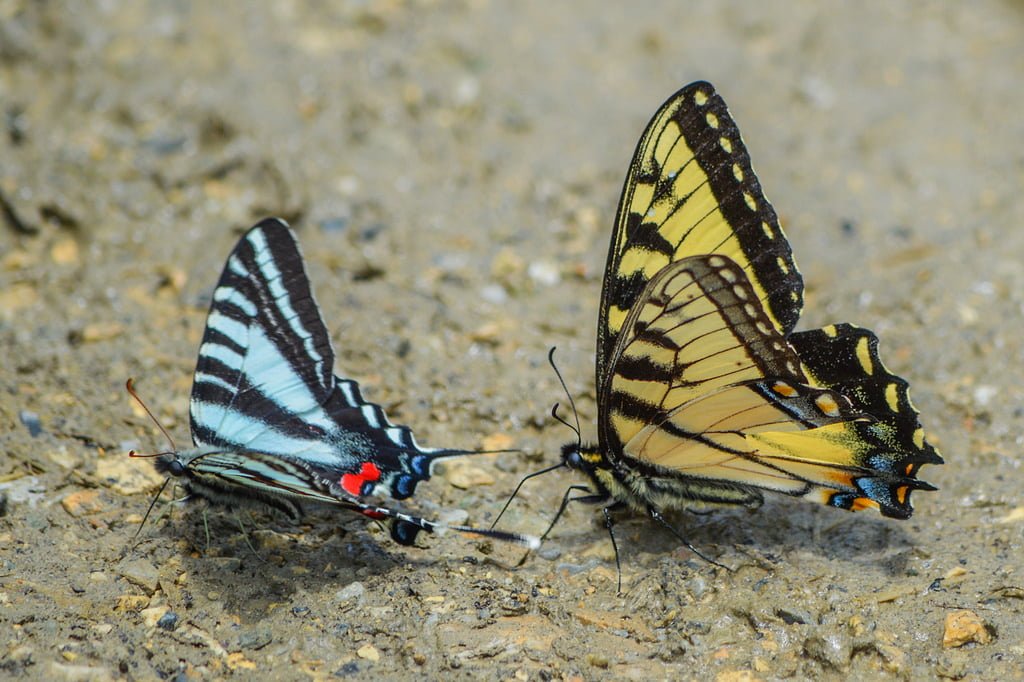The Tiger Swallowtail (Papilio glaucus) and the Zebra Swallowtail (Protographium marcellus) are both species of butterflies and belong to the Papilionidae family. While they share some similarities, there are several notable differences between them:
Appearance:
Tiger Swallowtail:
The Tiger Swallowtail is a large butterfly with a wingspan ranging from 7 to 10 centimeters (2.8 to 4 inches). The upper side of the male’s wings is yellow with black stripes, resembling a tiger’s pattern, hence the name. The female can have two forms: a yellow form similar to the male and a dark form with blue and black markings.

Zebra Swallowtail:
The Zebra Swallowtail is also a large butterfly, but slightly smaller than the Tiger Swallowtail, with a wingspan of about 6 to 9 centimeters (2.4 to 3.5 inches). It has distinctive black and white-striped wings. The hind wings have long, slender tails, giving them a zebra-like appearance.

Wing Patterns
– Tiger Swallowtail:
The male Tiger Swallowtail has prominent black stripes running across its yellow wings. The stripes are more extensive and bolder compared to the female. The female can have a similar pattern, but she may also have a dark form where the wings are predominantly black with blue and black markings.
– Zebra Swallowtail:
The Zebra Swallowtail has a striking black and white striped pattern on its wings, resembling the stripes of a zebra. The wings are predominantly white with bold black stripes, giving them a highly contrasting appearance.
Geographic Range
– Tiger Swallowtail:
The Tiger Swallowtail is found across North America, ranging from southern Canada down to Mexico and Central America.
– Zebra Swallowtail:
The Zebra Swallowtail is primarily found in the eastern and southern parts of the United States, including the Great Lakes region, the Atlantic coast, and parts of the Midwest.
Host Plants
– Tiger Swallowtail: The larvae (caterpillars) of the Tiger Swallowtail feed on a variety of tree species, including tulip tree (Liriodendron tulipifera), sweetbay magnolia (Magnolia virginiana), and wild cherry (Prunus spp.).

– Zebra Swallowtail: The larvae of the Zebra Swallowtail have a more specific diet. They primarily feed on the leaves of pawpaw trees (Asimina spp.), which are native to the eastern and southern United States.

These are some of the key differences between the Tiger Swallowtail and the Zebra Swallowtail butterflies. Their distinct wing patterns, geographic ranges, and host plant preferences contribute to their unique characteristics and make them somewhat easily distinguishable from each other.

The Adventures of Johnny Butterflyseed – Author Signed First Edition Children’s Book
Save the monarchs!
Johnny Butterflyseed and his fairy friend, Raven Silverwing, embark on a mission to save the rapidly disappearing butterflies. They enlist the help of Queen Venus Goldwing and her kingdom of monarchs to educate and inspire kids to become butterfly farmers. At first, Johnny faces his own internal struggle with self-doubt and fear in his ability to make a difference, but then soon develops a mindset that allows him to not only get started, but also make progress one day at a time. Through challenge after challenge, Johnny learns that he is not alone in his mission and that there are many people who want to help. Together, Johnny, Raven, and Queen Venus educate thousands of children on becoming butterfly farmers.
More important than perfect identification is creating the proper ecology for butterflies so we can continue to see them flutter about our world.. one day at a time!

